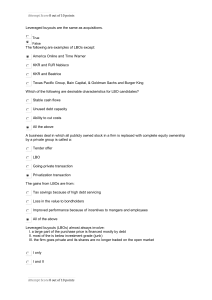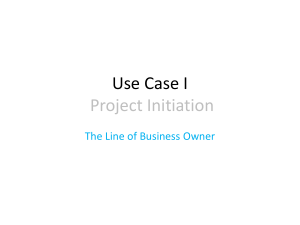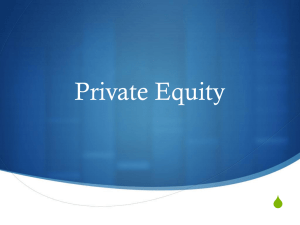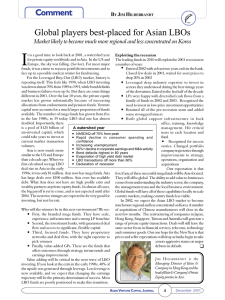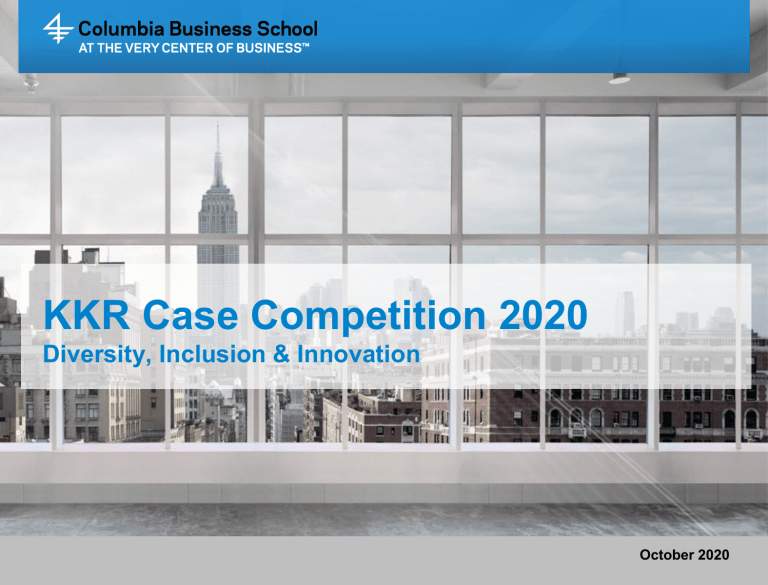
KKR Case Competition 2020 Diversity, Inclusion & Innovation October 2020 2 3 Include slide on your team and its diversity 4 Diversity How Diversity Makes us Smarter by Professor Katherine W. Phillips ● Decades of research by organizational scientists, psychologists, sociologists, economists and demographers show that socially diverse groups (that is, those with a diversity of race, ethnicity, gender and sexual orientation) are more innovative than homogeneous groups. ● It seems obvious that a group of people with diverse individual expertise would be better than a homogeneous group at solving complex, nonroutine problems. It is less obvious that social diversity should work in the same way—yet the science shows that it does. ● This is not only because people with different backgrounds bring new information. Simply interacting with individuals who are different forces group members to prepare better, to anticipate alternative viewpoints and to expect that reaching consensus will take effort. McKinsey Report: Why Diversity Matters (2015) ● Companies in the top quartile for racial and ethnic diversity are 35 percent more likely to have financial returns above their respective national industry medians. ● Companies in the top quartile for gender diversity are 15 percent more likely to have financial returns above their respective national industry medians. ● Companies in the bottom quartile both for gender and for ethnicity and race are statistically less likely to achieve above-average financial returns than the average companies in the data set (that is, bottom-quartile companies are lagging rather than merely not leading). 5 Competition Timeline ● ● ● ● ● ● October 14: Reception at KKR October 27: Deadline to submit team roster to the Private Equity Program November 5: Final PowerPoint deck for presentation submitted to the Private Equity Program November 16: Finalists selected and notified if they will be invited to present on November 18 November 18: Finalists will present to a panel of private equity professionals at KKR. Winning team to be announced. November 24: Wiining Team will have an exclusive virtual session with Henry Kravis ‘69. Individual and Team Advising ● Students and teams may sign up to meet with Michael Hillmeyer from the PE Program using the following link: calendly.com/michaelhillmeyer 6 Sourcing - Watson Library Resources ● ● ● ● ● ● ● ● ● ● ● Databases Preqin Thomson One [Internet Explorer Browser ONLY; Initiation reports best] Business Source Complete Capital IQ [requires account] Factiva Proquest Direct Ibis world SEC/ Edgar Bloomberg There are ten Bloomberg terminals available across the Libraries: seven in the Watson Library; one terminal in Lehman Social Sciences Library in Lehman Library Teams should reference the target company’s public filings (10-K, 10-Q, investor presentations, earnings releases and earnings transcripts) as well as research reports available through CapitalIQ. 7 Investment Thesis: Basics Company • What does the company do? • How does it make money? • Who are its customers? • Who are its suppliers? • How does the company sell products/services? • Why do customers buy the products/services? • Why do they buy from the company in particular Industry • How big is it? • Does it grow? • Is it cyclical or seasonal? • What are current trends? Competitive Marketplace • How many competitors? • How big are market shares? • Do competitors compete on price or value? Source: Competition Demystified, Bruce Greenwald 8 Investment Thesis: Price and Value Proposition How good a business is the company? - The answer determines price you want to pay How will you drive value creation? - is the target a good fit with your firm? 9 Investment Thesis: What is a Good Business? • Predictable, recurring and growing FCF over the long term using minimal capital investment • High probability of the company achieving projected profitability 10 Investment Thesis: Feedback From 2019 Competition Clarity Have a CLEAR investment thesis (being undervalued compared to competitors is not a good enough of a thesis) You need to explicitly state why you believe you could make money Articulate why this specific business is the one you chose- explain fundamentally how this is a good business Clearly express what you believe the catalyst for growth will be going forward and how you plan on operating more efficiently Identify KKR value proposition Thoughtfulness Have charts that display growth projections or how comps have grown Include a broader discussion of industry trends Develop an elaborated detailed business plan and implementation timeline, including exit strategy Creativity Don’t be afraid to find deal ideas in unusual places Not enough to have an interesting idea- you need to explain your thinking Have an angle or differentiator to show creativity Justify why it is an attractive market to be in Explain the downside as well - have follow up details around risks and mitigants Check for typos! Competition 2019 Feedback 11 Diligence: Key Issues for LBO Investments • Price • Growth (industry/company) • Leverage/Cash Flow • Market • Management • Geography • Exit Source: MFG Partners 12 Diligence: More Issues to Consider • Comps (Public / Private) • Legal / Environmental • Customer (Concentration/Power over) • Capital intensity • Cyclicality • Performance in a recession? • M&A/synergy opportunities Source: MFG Partners 13 Diligence: The Fund’s Perspective • Size of the deal • # of portcos in the fund; time to next fundraise • Work required • Style • Source • Financing sources • Upside Downside KNOW THY FIRM Source: MFG Partners 14 Diligence: Feedback From 2019 Competition ● Make sure to do financial diligence ● Show thoughtful comps ● Have a page on potential risk of investment clearly laid out ● Make sure to show work around the market dynamics Competition 2019 Feedback 15 Ten red flags of operational due diligence – Tao Tan ‘11 1. Operating cash flow. Is it steady and rigorous? 2. Adjusted EBITDA. Is there true earnings power vs. add-backs and one-timers? 3. Stress test. Will sudden revenue loss or cost increase strain the company’s liquidity? 4. Management. Does management pass the safe hands test? 5. Organizational alignment. Can employees up and down articulate the strategy and direction? 6. Ability and drive to execute. Can your management pivot to a PE operator mindset? 7. Value trap. Are your improvement levers straightforward to monetize? 8. Exit planning. Who or what would buy this company at the exit? 9. Disruption. Are there sudden events or competition on the horizon? 10. Pre-mortem. What else could possibly go wrong? 16 LBO Modeling: Purpose What would a financial buyer be willing to pay? – Iterative modelling exercise to determine maximum equity purchase price a sponsor could pay – Subject to return and risk constraints • Internal Rate of Return (IRR) = 20%+ • Exit within 5-7 years • Total Debt / EBITDA <= ~6.0x • Must able to pay off 50% of debt within 5 years • Limited if any synergies LBO Modeling: Resources PE Program Resources for LBO Modeling – LBO Technical Note – Gaby Baum ‘19 Solved LBO Model – Other LBO Resources on PE Program web site (password protected) Other Resources – PE Club LBO Training – Rosenbaum & Pearl - Investment Banking, 2nd Ed LBO Modeling: Tools Short Form Model Long Form Model – Limited information, assumptions, and analysis – Extensive information, assumptions, and analysis – Positive: a “one-pager,” quick and determines whether the deal is viable / warrants further analysis – Positive: accommodates multiple operating and capital cases, detailed transaction elements, ownership, and returns analysis – Negative: limits operating and capital cases, transaction elements, ownership, and returns analysis – Negative: can take 1-2 days to complete and can be difficult to use 19 LBO Modeling: Short Form Model LBO Modeling: Steps ● Excel Setup ● Operating Case ● Debt Schedule – Payments – Income Statement – Principal & Interest – Balance Sheet – Credit Analysis – Cash Flow Statement ● Transaction Case – Transaction Value ● Returns – Returns Analysis – Sensitivity Analysis – Sources & Uses 21 LBO Modeling: Excel Setup ● File…Options…Formulas…Enable Iterative Calculations – Always OFF when in “build” mode to alert for accidental, unwanted circular references • Circularities typically develop via Cash, Debt, and Interest Income / Expense – Turn ON after model is complete to utilize stable, forced circular references ● Inputs: Blue / Outputs: Black / Links: Green LBO Modeling: Operating Case LBO Modeling: Income Statement Drivers – Revenue (% Growth) – EBITDA Margin (% of Revenue) – Tax Rate (% of EBT) – Interest Expense (% of Average Debt) LBO Modeling: Balance Sheet Drivers – Capex (% of Revenue) – Depreciation (% of Beginning P,P&E) – ∆NWC (% of ∆Revenue) LBO Modeling: Cash Flow Statement Cash Flow Available for Debt Repayment – EBITDA – Less: Interest Expense – Less: Taxes – Less: Change in NWC – Less: Capital Expenditures LBO Modeling: Transaction Case LBO Modeling: Transaction Value Multiple Method – EBITDA Multiple – LTM EBITDA – Net Debt (Cash) Premium Method – Unaffected Share Price (Close Day Before Announcement) – Premium Paid (% of Share Price) – Basic Shares Outstanding – Options Outstanding – Average Exercise Price – Net Debt (Cash) 28 LBO Modeling: Sources & Uses Sources – Credit Revolver – Senior Secured Debt Uses – Equity Purchase Price • Term Loan A, B, C – Existing Debt Refinance • Notes / High Yield – Financing Fees (% of Debt) – Senior Unsecured Debt – Junior / Subordinated Debt • Mezzanine – Advisory Fees (% of TEV) • Sponsor • Management / Rollover – Operating Cash – Equity – Existing Cash 29 LBO Modeling: Debt Schedule LBO Modeling: Payments Mandatory Repayments – Senior Secured Debt – Senior Unsecured Debt Sweep Repayments – Senior Secured Debt – Senior Unsecured Debt – Junior / Subordinated Debt – Other Debt 31 LBO Modeling: Principle & Interest Principal Repayments – Amortization (Mandatory Periodic Payments) (% of Beginning Balance) – Bullet (Mandatory at End) (100% of Beginning Balance) – Sweep (Discretionary Cash Flow) (Minimum of Available Cash Flow or Beginning Balance) Interest Expense – Cash or Paid-in-Kind (PIK) – Interest Rate x Average Debt Balance (creates circularity) – Senior Secured Debt = Floating Rate (LIBOR + Spread) – Senior Unsecured Debt = Fixed Rate – Junior / Subordinated Debt = Fixed Rate 32 LBO Modeling: Credit Statistics LBO Modeling: Credit Analysis Leverage – Senior Secured Debt / EBITDA – Senior Unsecured Debt / EBITDA – Junior / Subordinated Debt / EBITDA Coverage – EBIT / Interest Expense – EBITDA / Interest Expense – (EBITDA – Capex) / Interest Expense – Total Debt / EBITDA – Total Debt / (EBITDA – Capex) 34 LBO Modeling: Returns LBO Modeling: Returns Analysis Equity Value at Exit Measurement – Exit Year EBITDA – IRR (%) (20%+ Target) – x Exit Multiple – Cash on Cash (Multiple of – = Enterprise Value – + Cash – - Senior Debt Investment) – By Owner (Sponsor, Rollover) Drivers – Leverage & Tax Shield – - Subordinated Debt – Revenue Growth – =Equity Value – Margin Improvement – x Ownership % – Efficiency Improvement – Multiple Expansion 36 LBO Modeling: Sensitivity Analysis Transaction – Premium Paid – Entry Multiple – Leverage – Interest Rates Operations – Financials (Growth, Margins, etc.) – Synergies (Margins, Investments, etc.) – Exit Multiple – Exit Year 37 LBO Modeling: Feedback From 2019 Competition • Have a reconciliation of underwritten Ebitda (explain and justify all financial assumptions) – are you backing out appropriate adjustments? • Clearly stated rationale for everything • Have a justification for your exit multiple and a discussion of exit strategy • Don’t just give limited insights into valuation and path to exit • Lay out cashflow • Can use appendix for some things- (ex: don’t need market beta charts up front) • Don’t have superficial model pages with no details of historicals and % growth and margins. • Explain why IRR is compelling vis a vis the risk taken • Make sure your returns up front are consistent with your sensitivity analysis in back Competition 2019 Feedback 38 Appendix ● Private Equity Value-Add ● Presenting ● Key to the Investment Committee Considerations for the Investment Committee 40 Source: Deal Camp 41 42

